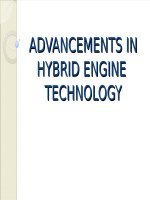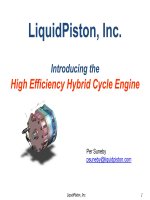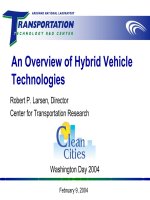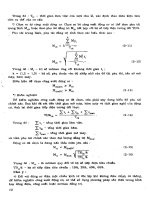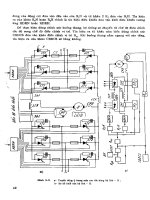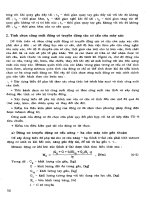Động cơ Hybrid - Thiết kế
Bạn đang xem bản rút gọn của tài liệu. Xem và tải ngay bản đầy đủ của tài liệu tại đây (736.88 KB, 15 trang )
February 9, 2004
An Overview of Hybrid Vehicle
Technologies
Robert P. Larsen, Director
Center for Transportation Research
Washington Day 2004
Hybrid Vehicle Technologies Hold
Great Potential but Face Barriers
Great Potential
• HEVs have demonstrated significant potential to reduce fuel
consumption and exhaust emissions
• Advances in battery, power electronics technologies have made
commercialization possible
• Performance is generally as good as or better than CVs
Real Barriers
• Extra complexity adds significant cost
• Fuel efficiency improvements will vary
– By hybrid vehicle type
– By application
– By driving cycle
Hybrid Powertrain Topology
Conventional
Electric
Motor
Engine
Battery
Electric
Motor
Battery
Micro Hybrid
Full Hybrid
Electric Vehicle
Range extender
Series Hybrid
Parallel
Fuel Cell
Series
Mild Hybrid
Generator
Engine
Fuel Cell
Key Features of Hybrids, or
How Do They Do It?
Hybrids achieve improved efficiencies
using several approaches:
• Employ regenerative braking to
recover energy that is thrown away
• Downsize or “right-size” the engine
or primary power source
• Control the engine or primary power
source to operate more efficiently
and/or work more often in a more
efficient range
Other vehicle modifications applied to
hybrids like aerodynamic
improvements, low rolling resistance
tires can be applied to CVs too
Hybrids Can Have Multiple
Configurations
Series (fuel cell)
Parallel
Starter-Alternator
Power Split
Graphics: Toyota Motor Corporation
What Are Key Characteristics of
HEV Configurations?
• 2- and 4-Wheel Drive
• Mechanical complexity
• Range of system voltages, battery
chemistries, electric complexity
• Sophisticated control strategies
• Multiple driving modes
• Multiple prime movers (engines, fuel
cells)
• Multiple fuels (including hydrogen)
ParallelSeries

